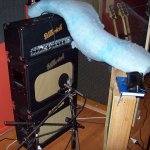Good point. I'll give it a try. I might be hearing very different things.
Does it make sense to track a condenser mic as well in the room?
I always track with a variety of mics at once on a cab so I can dial in whatever works best for the song later. HOWEVER, that's not to say that you can't get
a stellar recording with just an
SM57!

But back to my original statement, one of the mics I always have set up when tracking electric guitar amps is a condensor as a room mic. I know the room that i track guitars in, so I've learned the best spot for it and the best height/angle for it to be. For my preferences, I set it to cardioid, and engage the high pass filter (mine is set at 80 hz roll off). Just less rolling off with plugin eq's later. Gets you that much closer to the final sound going in. Watch for phase problems with the close mic(s) though - if it's out of phase don't just try flipping the phase because it may still sound phasey (things aren't always 180 degrees out of phase)! Rather, get the placement right so the phase is spot on going in. Use a phase scope and have your monitoring in mono when checking for more accuracy, especially if your ears can't hear it.
You can do omni or figure eight on a room mic if you want more off axis stuff and not the direct source, or point the cardioid pattern away from the amp at a wall. But I prefer it maybe a foot or two higher than the cone, maybe 10 feet away, pointing down towards the cone to grab some bare floor reflections on the way (and not allow ceiling reflections), with a packing blanket behind the mic. Works for me anyways...every time.
Funny thing is, any guitarist instantly LOVES the sound of the close mic (or a combo of close mics such as 57/421 said Steen), blended with the room mic. Why? Probably because it sounds closer to what they are used to hearing. I think of it like micing drums, you don't just use close mics as that is not what your ear is used to hearing. You use overhead and/or ambient mics further away to get a more natural sound when blended. Close mics for attack/punch/detail, far mics for space and a more natural sound.
Just some stuff that works FOR ME, and I'm sure millions of others. Great on guitar leads/solos especially btw. Depends on the style...metal guitars? Probably not. Indie/roots rock? Crank up that room! Maybe ONLY use the room?!

Goodbye room reverb emulation plugins!

Good luck!



 Goodbye room reverb emulation plugins!
Goodbye room reverb emulation plugins! 

